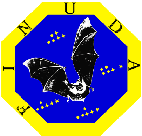

The FINUDA Online Monitoring
and Event Display System
It may get an input from two different sources, selected by a flag given
as an argument when the program is started:
 The RDT event, from the DAQ system, is stored in
the Global Event Builder (GEB) memory as an array of unsigned integers,
and then written to file and, eventually, sent to the Online Monitoring System
through a UDP socket.
The RDT event, from the DAQ system, is stored in
the Global Event Builder (GEB) memory as an array of unsigned integers,
and then written to file and, eventually, sent to the Online Monitoring System
through a UDP socket.
 The Online Monitor is organized into two separate and sequential stages:
The Online Monitor is organized into two separate and sequential stages:
and
 The geb2hdt process runs in batch mode and
takes care of the event pre-analysis:
it connects to the Database (mSQL) and stores into a
TFndFeeMap
object all the information needed to map the electronic channel numbers of
ADC and TDC modules
into a meaningful set of parameters,
uniquely identifying the physical channels
(slabs, strips, wires, tubes).
The geb2hdt process runs in batch mode and
takes care of the event pre-analysis:
it connects to the Database (mSQL) and stores into a
TFndFeeMap
object all the information needed to map the electronic channel numbers of
ADC and TDC modules
into a meaningful set of parameters,
uniquely identifying the physical channels
(slabs, strips, wires, tubes).
 Once the input source and the database information are defined,
geb2hdt starts a loop on events, which is infinite in online
mode and defined by the number of events in the file in offline mode.
Once the input source and the database information are defined,
geb2hdt starts a loop on events, which is infinite in online
mode and defined by the number of events in the file in offline mode.
 As a first step, the Raw Event is organized into a structure described by the
TFndRdt class and stored into a Raw ROOT tree
with many branches, containing different kinds of information, but
still in encoded format:
As a first step, the Raw Event is organized into a structure described by the
TFndRdt class and stored into a Raw ROOT tree
with many branches, containing different kinds of information, but
still in encoded format:
 Then, the event is transformed into a structure described by the
TFndHdt class, containing:
Then, the event is transformed into a structure described by the
TFndHdt class, containing:
 The events in TFndHdt (Hit Data Tape) format are
stored on file as a ROOT tree,
accessible for local or (via the Web) remote detector control
by the froot consumers.
The events in TFndHdt (Hit Data Tape) format are
stored on file as a ROOT tree,
accessible for local or (via the Web) remote detector control
by the froot consumers.
 At the same time, geb2hdt stores a set of histograms
into the following set of shared memories, which are periodically updated
and accessible at any time.
At the same time, geb2hdt stores a set of histograms
into the following set of shared memories, which are periodically updated
and accessible at any time.
 The froot(s) consumer session(s) run(s) interactively an
extended ROOT executable,
which includes the FINUDA Classes, and can
access:
The froot(s) consumer session(s) run(s) interactively an
extended ROOT executable,
which includes the FINUDA Classes, and can
access:
The design was kept as user friendly as possible, in
order to simplify the operator task during the
data taking. Nevertheless, the HDT contains the whole event information:
all the variables can be correlated to each other, in case of need, to
investigate unexpected troubles.
Back to the
FINUDA Software homepage
PC
(update 27 Jan 99)